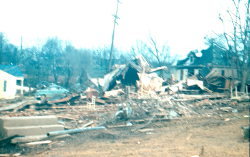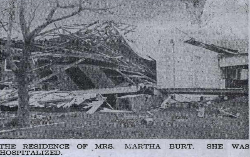
The 2002 Veterans Day weekend tornado outbreak was an unusually severe and expansive severe weather event across portions of the Central and Eastern United States from the evening hours of November 9 into the early morning hours of Veterans Day, November 11, 2002. A series of troughs tracked eastward across the United States, providing strong wind shear, while anomalously warm and unstable air surged northward into the Ohio River Valley. As a result, multiple tornadoes occurred across Arkansas, Tennessee, and Missouri on November 9. A far more widespread and severe event occurred the following day, with three distinct tornado outbreaks focused across areas from Illinois to Pennsylvania; Tennessee and Kentucky; and areas from Mississippi to South Carolina. The most intense tornado of the outbreak was a violent F4 tornado that occurred near Van Wert, Ohio. A total of 76 tornadoes occurred during the 3-day period, collectively resulting in 36 deaths and 303 injuries. As of 2022, the event ranks as the third-largest tornado outbreak on record in November.
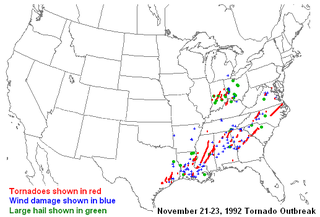
The Tornado outbreak of November 1992, sometimes referred to as The Widespread Outbreak, was a devastating, three-day outbreak of tornadoes that struck the Eastern and Midwestern United States on November 21–23. This exceptionally long-lived and geographically large outbreak produced 95 tornadoes over a 41-hour period, making it one of the longest-lasting and largest outbreaks ever recorded in the US, and published studies of the outbreak have indicated the possibility of even more tornadoes. There were 26 fatalities, 641 injuries, and over $300 million in damage.

This page documents notable tornadoes and tornado outbreaks worldwide in 2004. Strong and destructive tornadoes form most frequently in the United States, Bangladesh, and Eastern India, but they can occur almost anywhere under the right conditions. Tornadoes also develop occasionally in southern Canada during the Northern Hemisphere's summer and somewhat regularly at other times of the year across Europe, Asia, and Australia. Tornadic events are often accompanied with other forms of severe weather, including strong thunderstorms, strong winds, and hail.
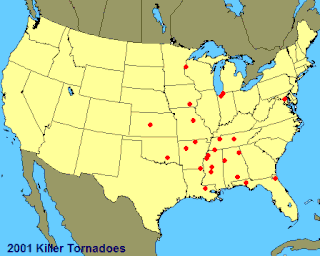
This page documents notable tornadoes and tornado outbreaks worldwide in 2001. Strong and destructive tornadoes form most frequently in the United States, Bangladesh, and Eastern India, but they can occur almost anywhere under the right conditions. Tornadoes also develop occasionally in southern Canada during the Northern Hemisphere's summer and somewhat regularly at other times of the year across Europe, Asia, and Australia. Tornadic events are often accompanied with other forms of severe weather, including strong thunderstorms, strong winds, and hail.
The tornado outbreak of April 1–2, 1974, affected much of the eastern and central United States. Four fatalities and more than seventy injuries were confirmed in this outbreak. Damaging, deadly tornadoes struck Kentucky, Tennessee, and Alabama—including the Nashville and Huntsville metropolitan areas. In the latter areas, tornadoes produced F3 damage on the Fujita scale and impacted areas that would later sustain damage on April 3. Large hail and severe thunderstorm winds also impacted a broad area.
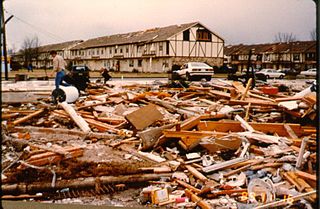
This page documents the tornadoes and tornado outbreaks of 1989, primarily in the United States. Most tornadoes form in the U.S., although some events may take place internationally. Tornado statistics for older years like this often appear significantly lower than modern years due to fewer reports or confirmed tornadoes.

This page documents the tornadoes and tornado outbreaks of 1983, in the United States. Most tornadoes form in the U.S., although some events may take place internationally. Tornado statistics for older years like this often appear significantly lower than modern years due to fewer reports or confirmed tornadoes.

This page documents the tornadoes and tornado outbreaks of 1974, primarily in the United States. Most tornadoes form in the U.S., although some events may take place internationally. Tornado statistics for older years like this often appear significantly lower than modern years due to fewer reports or confirmed tornadoes.
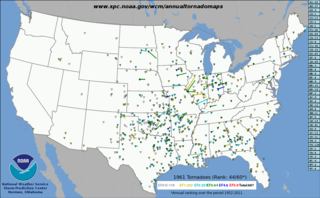
This page documents the tornadoes and tornado outbreaks of 1961, primarily in the United States. Most tornadoes form in the U.S., although some events may take place internationally. Tornado statistics for older years like this often appear significantly lower than modern years due to fewer reports or confirmed tornadoes.

A deadly tornado outbreak severely impacted the Southern United States, and also affected Iowa and Nebraska to a lesser extent, between November 27–30, 2016. The strongest tornadoes of the event affected Alabama and Tennessee during the late evening of November 29 and into the early morning hours of November 30. Overall, this outbreak produced 48 tornadoes, killed six people, and injured many others.

This page documents the tornadoes and tornado outbreaks of 1957, primarily in the United States. Most tornadoes form in the U.S., although some events may take place internationally. Tornado statistics for older years like this often appear significantly lower than modern years due to fewer reports or confirmed tornadoes.

This page documents the tornadoes and tornado outbreaks of 1954, primarily in the United States. Most tornadoes form in the U.S., although some events may take place internationally. Tornado statistics for older years like this often appear significantly lower than modern years due to fewer reports or confirmed tornadoes.

This page documents the tornadoes and tornado outbreaks of 1953, primarily in the United States. Most tornadoes form in the U.S., although some events may take place internationally. Tornado statistics for older years like this often appear significantly lower than modern years due to fewer reports or confirmed tornadoes. This was the first year to record an F5 tornado as well as one of the deadliest tornado seasons in official U.S. records, which go back to 1950.

This page documents the tornadoes and tornado outbreaks of 1952, primarily in the United States. Most tornadoes form in the U.S., although some events may take place internationally. Tornado statistics for older years like this often appear significantly lower than modern years due to fewer reports or confirmed tornadoes.
This page documents the tornadoes and tornado outbreaks of 1951, primarily in the United States. Most tornadoes form in the U.S., although some events may take place internationally. Tornado statistics for older years like this often appear significantly lower than modern years due to fewer reports or confirmed tornadoes.
This page documents the tornadoes and tornado outbreaks of 1950, primarily in the United States. Most tornadoes form in the U.S., although some events may take place internationally.
A widespread, destructive, and deadly tornado outbreak sequence affected the Southeastern United States from April 28 to May 2, 1953, producing 24 tornadoes, including five violent F4 tornadoes. The deadliest event of the sequence was an F4 tornado family that ravaged Robins Air Force Base in Warner Robins, Georgia, on April 30, killing at least 18 people and injuring 300 or more others. On May 1, a pair of F4 tornadoes also struck Alabama, causing a combined nine deaths and 15 injuries. Additionally, another violent tornado struck rural Tennessee after midnight on May 2, killing four people and injuring eight. Additionally, two intense tornadoes impacted Greater San Antonio, Texas, on April 28, killing three people and injuring 20 altogether. In all, 36 people were killed, 361 others were injured, and total damages reached $26.713 million (1953 USD). There were additional casualties from non-tornadic events as well, including a washout which caused a train derailment that injured 10.
A widespread and deadly tornado outbreak affected the Great Plains, Mississippi Valley, and Southeast between March 12–15, 1953. At least 23 tornadoes were confirmed with the strongest one reaching F4 intensity and striking O'Brien, Texas on Friday the 13th. Overall, 21 people were killed, 72 others were injured, and damages were estimated at $6.835 million (1953 USD). There were additional casualties from non-tornadic events as well.

The first six days of December 1953 produced a destructive and deadly tornado outbreak sequence across the Southern United States. There were 19 confirmed tornadoes, including a violent F4 tornado that hit the northwest side of Alexandria, Louisiana and even more violent F5 tornado that hit Vicksburg, Mississippi. In all, the tornadoes killed 49 people, injured 404 others, and caused $45,709 million in damage. The death toll made this deadliest December tornado outbreak ever recorded and it would not be surpassed until 2021. This was also the last of the series of deadly and catastrophic tornado outbreaks to strike the US in 1953.
Between April 23–30, 1961, a tornado outbreak sequence struck the Midwest, Ohio, and Mississippi Valleys, and the Eastern United States. Large hailstorms accompanied the tornadoes as well and numerous other weather events also occurred. Three people were killed, 38 others were injured and losses totaled $26.810 million. Two additional fatalities also occurred due to flooding and lightning.


